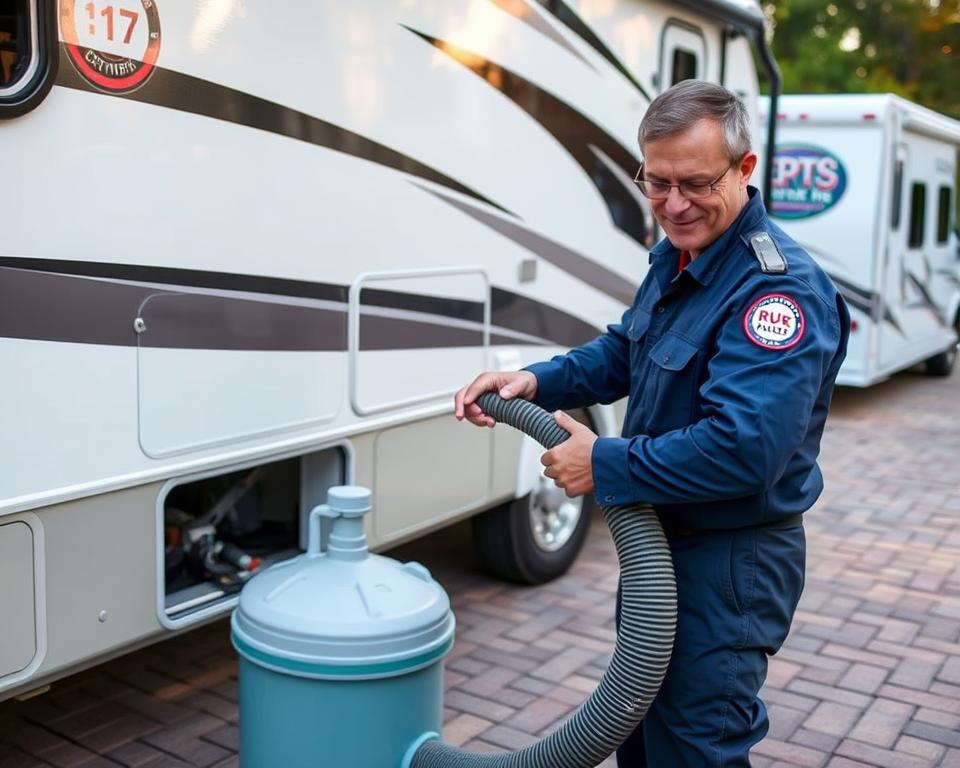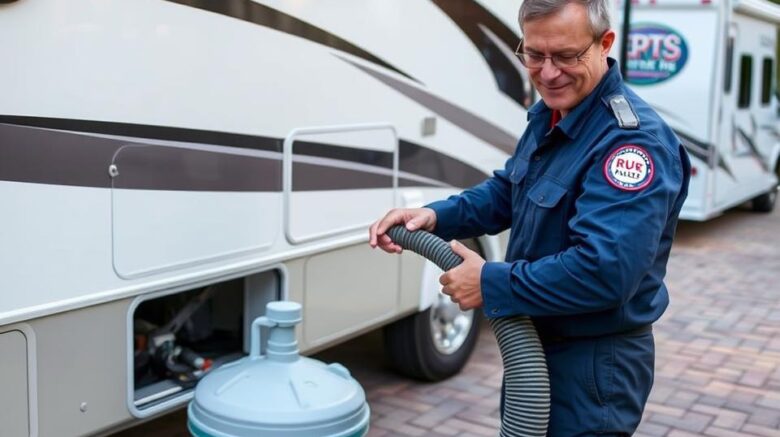RV Wastewater Pump Guide: Vital Upkeep Recommendations
Ever considered the workings of your camper’s waste disposal system? Grasping the intricacies of your RV sewer pump can avert mishaps, enhancing your camping excursions. It’s centered on handling waste productively and dodging unpleasant aromas. In this handbook, you’ll discover essential maintenance methods for RV septic tank pumping near me. Each strategy is created to support your sewer network’s best operation.
Grasping Your Camper Waste Pump Configuration
The camper sewage pumping setup is vital for waste management, making camping more enjoyable. It consists of two key tanks: the black-water reservoir for toilet waste and the grey-water reservoir for water from wash basins and shower stalls. Telling apart these tanks is important to ward off clogs and keep your RV performing optimally.
An RV waste grinder is a widely used solution for waste management. It shreds solid waste into minute particles, easing disposal. In contrast, a traditional camper sewage pump is available. It efficiently moves waste without pulverizing, for those seeking a simpler option.
Understanding your RV’s waste pump setup is essential to avoiding problems and ensuring clean inspections. Using the system correctly can prevent messes, improving your outdoor adventures.
Significance of Routine Care
Upkeeping your RV sewage disposal pump is vital for a smooth travel experience. Without proper upkeep, you may run into odors, clogs, or backups. These complications can wreck your road trips.
Consistent servicing thwart such issues and extend your system’s life. By inspecting hoses and seals, you boost efficiency. A duly maintained RV sewage pump guarantees smooth waste disposal, letting you enjoy uninterrupted travels.
Frequent upkeep also leads to financial savings over time. Disregard can cause major issues, requiring high-cost fixes. Committing to regular maintenance keeps your motorhome in prime shape, saving money long term.
How Frequently to Service Your RV Septic Tank?
Knowing the right time to pump your RV Septic Tank is vital for its upkeep. It’s best practice to pump every 3–5 days during use. For quick getaways, post-trip emptying may be adequate.
Interval depends on various elements. Tank size and usage level are vital. Best practice is to pump when it reaches 66% capacity. This helps support steady waste movement and ward off blockages.
Observing your RV Septic tank levels is key for a smooth journey. Handle your camper’s effluent to stop issues while traveling.

Best Practices for Emptying Your Tanks
Safely purging RV tanks is vital for your motorhome’s sanitary condition and performance. Always empty first the black water tank to let the grey tank liquid rinse leftover solids. This method prevents clogs and ensures efficient drainage.
Select a top-grade drain hose for disposal. A robust hose stops leaks and ensures connections. Include a tank rinser for a complete flush, using water pressure to remove residual sludge, improving cleanliness.
Thorough draining prevents residue buildup, stopping foul odors and potential issues. To maintain an optimal sewage system in your motorhome, adhere to these guidelines:
- Regularly use a tank treatment to manage smells and digest residue.
- Keep an eye on fill levels to avoid overflow situations.
- Perform routine pump inspections for clogs and wear.
- Perform a deep tank flush every 4–8 weeks, even during occasional use.
Implementing these practices enhances your sewage system’s longevity and performance, ensuring smooth journeys.
Keeping Smells and Blockages at Bay
For a memorable adventure, avoiding stench is essential. Ensure tanks have sufficient water to aid in breaking down waste, stopping unpleasant odors. Also, using RV-safe toilet paper helps prevent clogs, avoiding backups.
For enhanced refuse control in campers, try bio-agent additives. These process sludge thoroughly, reducing effort. Regularly inspect the vent pipe to keep air moving freely in the plumbing system.
Cautious flushing is key to avoiding tank issues. Refrain from disposing of wipes, feminine products, and paper towels. These non-compostable materials can cause major clogs. Adhering to these guidelines helps maintain a more sanitary camping environment.
Maintenance Advice for RV Sewage Pumps
Maintaining your RV’s sewer pump system is essential for trouble-free travels. Inspect dump valve seals regularly to prevent leaks. Worn seals can cause surprise messes, harming your RV.
To remove stench and maintain cleanliness, sanitizing is essential. Perform a deep clean every few months to avoid deposits, ensuring the system operates smoothly. These steps are essential for maintaining a portable RV pump, promoting durability and reliable functionality.
Lubricating valves is another important task. It helps stop leaks and maximize functionality. Monitoring tank sensors is key for precise measurements, preventing overflows and unexpected pump issues. Maintaining vigilance makes your RV adventures spotless and more enjoyable.
Indicators You Need Expert Pumping
Identifying septic problems ahead can protect you from costly repairs. A tell-tale indicator you need a professional pump-out is slow draining. When sinks and toilets take longer to clear, it often points to obstructions. It suggests your system may be clogged.
Persistent odors are another distinct indicator of sewage troubles. Stench that won’t go away despite cleaning suggest trapped waste. It’s crucial to check the transparent elbow fitting when dumping waste. Visible residue signals it’s time for professional pump service.
Technicians utilize jet machines to blast through tough clogs efficiently. Ignoring these warnings can escalate into major problems. Therefore, it’s critical to seek help immediately when issues arise.
| Indicators of Sewer Trouble | Recommended Response |
|---|---|
| Delayed Drainage | Check obstructions; call expert service |
| Persistent Odors | Examine system; book professional RV pump-out |
| Obvious Debris | Contact pump service for thorough cleaning |
Selecting the Ideal RV Waste Grinder
When picking an RV macerator pump, assess its capacity, build quality, and compatibility with your RV’s size. A high-quality macerator is vital for efficiently breaking down waste. This is especially crucial for RVs requiring constant pumping. High-end pumps improve sewage handling, ensuring a smoother RV lifestyle.
A range of options cater to diverse needs. For an well-founded selection, focus on these critical elements:
- Capacity: Check output volume compatibility.
- Durability: Choose pumps with robust construction.
- Ease of Use: Prefer straightforward, easy-to-use models.
- Compatibility: Check plumbing compatibility.
Investing time in research when choosing an RV macerator pump optimizes travel enjoyment and ensures efficient pump performance.
Troubleshooting Your RV Sewer Pump
Proper troubleshooting for your RV sewer pump is crucial in resolving common sewage issues before they worsen. If you notice slow drainage, unexpected backups, or persistent odors, act quickly. These are clear signs of malfunction requiring attention.
First inspect the pump, its connections, and hoses. Look for any clogs that could slow flow. Ensure inlet and outlet fittings are properly connected. Also, verify the pump’s power supply for proper voltage.
If basic checks fail to reveal the issue, listen to the pump’s sound. A unit that’s overly noisy or abnormally quiet may have internal damage. Also, check for leaks, as these can magnify sewage problems. With these troubleshooting steps, many RV owners can find and fix issues early, avoiding costly repairs.
Ongoing Care for Your RV Pump
For long-term efficiency, commit to regular sewer pump upkeep. Flush the system consistently to prevent clogs. Establish and adhere to a maintenance routine, keeping everyone informed of their roles. This considerably increases your waste system’s lifespan.
Educating yourself and others on appropriate use is key. This avoidss issues and fosters shared responsibility. The result benefits both users and the sewer system.
- Inspect plumbing and hoses periodically
- Cleaning filters regularly
- Scheduling professional servicing annually
- Apply recommended conditioners
Sticking to these steps improves your camper’s sewage system’s durability and keeps it healthy, making travels more delightful.
Wrapping It Up
Keeping your RV sewer pump in prime condition is essential for uninterrupted camping adventures. Regular attention to RV sewer system maintenance drastically lowers problem risks, letting you engage in the journey. By knowing your system and applying reliable sewage methods, your trips will be free of waste management woes.
Implementing the key tips from this guide improves RV waste management and advances your travel comfort and safety. Keep your sewer pump in top shape by following best upkeep practices and addressing potential issues promptly.
Keeping informed about your RV sewer system brings dividends. It ensures homely comforts while exploring. Cheers to joyous and untroubled journeys!
FAQ
How can I tell it’s time to empty my RV Septic tank?
Pump the RV Septic tank when it hits 66% capacity.
Black tank vs. grey tank: what’s the difference?
The black tank holds toilet waste. Whereas, the grey tank collects water from basins and showers.
What is the recommended maintenance schedule for RV sewer pumps?
Check seals, sanitize, and clean quarterly.
Which products are best for RV sewer pump care?
Choose RV-approved enzyme formulas and quality hoses and rinsers.
How do I avoid clogs in my RV sewer system?
Use only RV-safe toilet paper.
What signs indicate I need professional RV pump-out?
Watch for slow drainage, recurring odors, or visible residue in the elbow.
How can I improve my RV macerator pump’s efficiency?
Select a correctly sized pump for your RV.
What should I check during a deep clean of my RV sewer system?
Inspect all connections and hoses.
Guidelines for extended RV pump care?
Train users on proper disposal.
How often should I empty my RV Septic tank with regular use?
Schedule pump-outs every 3–5 days.
